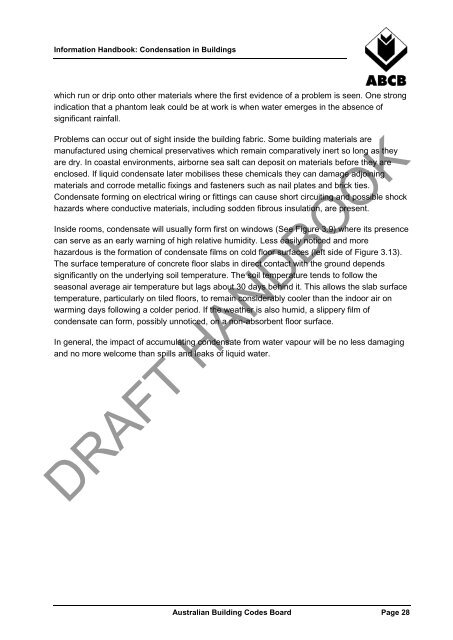Condensation in Buildings - Australian Building Codes Board
Condensation in Buildings - Australian Building Codes Board
Condensation in Buildings - Australian Building Codes Board
Create successful ePaper yourself
Turn your PDF publications into a flip-book with our unique Google optimized e-Paper software.
Information Handbook: <strong>Condensation</strong> <strong>in</strong> Build<strong>in</strong>gs<br />
which run or drip onto other materials where the first evidence of a problem is seen. One strong<br />
<strong>in</strong>dication that a phantom leak could be at work is when water emerges <strong>in</strong> the absence of<br />
significant ra<strong>in</strong>fall.<br />
Problems can occur out of sight <strong>in</strong>side the build<strong>in</strong>g fabric. Some build<strong>in</strong>g materials are<br />
manufactured us<strong>in</strong>g chemical preservatives which rema<strong>in</strong> comparatively <strong>in</strong>ert so long as they<br />
are dry. In coastal environments, airborne sea salt can deposit on materials before they are<br />
enclosed. If liquid condensate later mobilises these chemicals they can damage adjo<strong>in</strong><strong>in</strong>g<br />
materials and corrode metallic fix<strong>in</strong>gs and fasteners such as nail plates and brick ties.<br />
Condensate form<strong>in</strong>g on electrical wir<strong>in</strong>g or fitt<strong>in</strong>gs can cause short circuit<strong>in</strong>g and possible shock<br />
hazards where conductive materials, <strong>in</strong>clud<strong>in</strong>g sodden fibrous <strong>in</strong>sulation, are present.<br />
Inside rooms, condensate will usually form first on w<strong>in</strong>dows (See Figure 3.9) where its presence<br />
can serve as an early warn<strong>in</strong>g of high relative humidity. Less easily noticed and more<br />
hazardous is the formation of condensate films on cold floor surfaces (left side of Figure 3.13).<br />
The surface temperature of concrete floor slabs <strong>in</strong> direct contact with the ground depends<br />
significantly on the underly<strong>in</strong>g soil temperature. The soil temperature tends to follow the<br />
seasonal average air temperature but lags about 30 days beh<strong>in</strong>d it. This allows the slab surface<br />
temperature, particularly on tiled floors, to rema<strong>in</strong> considerably cooler than the <strong>in</strong>door air on<br />
warm<strong>in</strong>g days follow<strong>in</strong>g a colder period. If the weather is also humid, a slippery film of<br />
condensate can form, possibly unnoticed, on a non-absorbent floor surface.<br />
In general, the impact of accumulat<strong>in</strong>g condensate from water vapour will be no less damag<strong>in</strong>g<br />
and no more welcome than spills and leaks of liquid water.<br />
DRAFT HANDBOOK<br />
<strong>Australian</strong> Build<strong>in</strong>g <strong>Codes</strong> <strong>Board</strong> Page 28
















